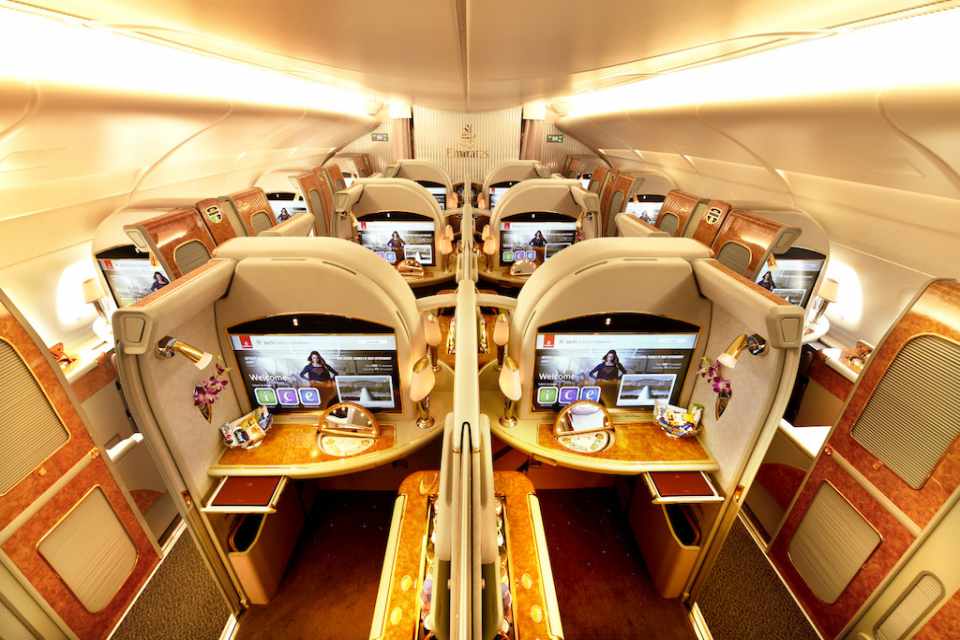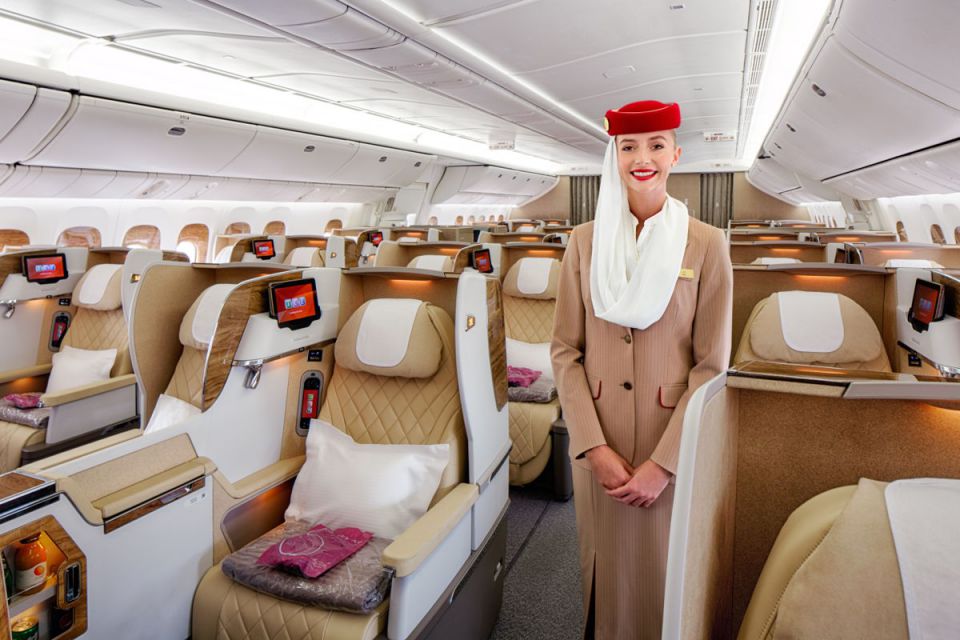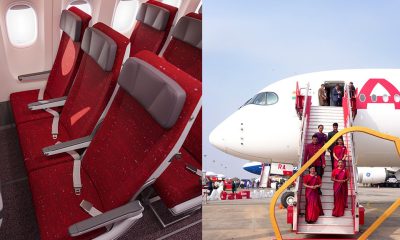Aviation
13 things you didn’t know about Emirates airlines

– Emirates founded in 1985 with two leased aircraft
- Backing from Dubai’s royal family with Pakistan international airlines.
- With $10 million as Start-up capital
Today revenue emirates are worth of $USD 25.8 billion
- Emirates growth has never fallen below 20% a year. In its first 11 years, it doubled in size every 3.5 years and has every four years since
- The Government has received Dirham 14.6 billion from Emirates since dividends started being in 1999 for having provided an initial-up capital of US $10 million.
- Emirates catering in numbers here’s how much food the facility goes through each year.
- 4 tons of chicken
- 58 million bread rolls
- 110,000kg of hummus
- 6 tons of lobster
- 3 million eggs
- 165 tonnes of salmon fillet
- 27 tonnes of fresh broccol
It has the world’s largest kitchen layout
- 10,000 staff members
- 500 chefs cook
– 88,000 square meter factory
– 2.5 km overhead monorail.
The finally-tuned operation caters 590 flights a day with authentic local cuisines giving customers a taste of the destinations they are going to.
That is annual there are 7000 different menu items and 254 different soups in First class alone.
Any given Day the emirates facility producers
- 7500 desserts for first and business class customers
- 65,000 desserts for economy class
- 15,000 muffins
- 12000 liters of tomato juice
–World first airline to have its own aviation university and flight training academy.
The college opened in 1991 and was transitioned to a university in December 2010
Programs are like
- Aeronautical Engineering
- Aviation Management
- Business Management
- Aviation Safety and security studies
- Graduates & Post Graduates Programs
A world-class Training Academy
It equipped with the 14 bay center houses 10 full-flight simulators.
-Emirates first introduced chauffer drive service for its passenger with the high end cars like Mercedes Benz, MNW and Volvo cars.
-World first airline to maintain highest no of Environmental Record
The airline claims to have lower emissions than other airlines. It has invested in a program called “tailored arrivals” arrival air traffic control to uplink to aircraft en-route. That huge saving.
How does it work?
It first determines the speed and flight profile from the air onto the runway, this allows the crew to accept and fly a continuous descent profile, saving fuel and emissions.
Emirates A380-800 if offers fuel economy o f3.1 liters per 100 passenger’s km. save 500,000 liters of fuel per aircraft per year. It also uses a program called Flex Trek it helps optimize routes efficiency and load factors.
-Emirates helped Sri Lankan airline to rebrand its national flag airline.
- In 1998 emirates purchased 43.6% in Sri Lankan airline for a worth of US $70 million
- In 2008, After 10 year’s Emirates sold its stake in the airline to the government of sri Lankan, in an estimated US$150 million.
-World’s first airline to Ban animal hunting and Transporting through its fleet.
In 2015 its support emirates made its fleets with decked out two of its A380 superjumbo jets in special livery designed to support United for wildlife a global campaign against the illegal wildlife trade.
-World’s largest floral installation through a life-size version of the Emirates A380.
- 5 million flowers
- Weigh over 100 tones
- 200 crew members worked
- 10 hours a day for
- -180 day to build
- 30-ton steel structures
-World’s Largest Maintain hanger in Dubai
The hanger size is equivalent 17 football fields or 9 hectares area the hanger was opened in 2010.
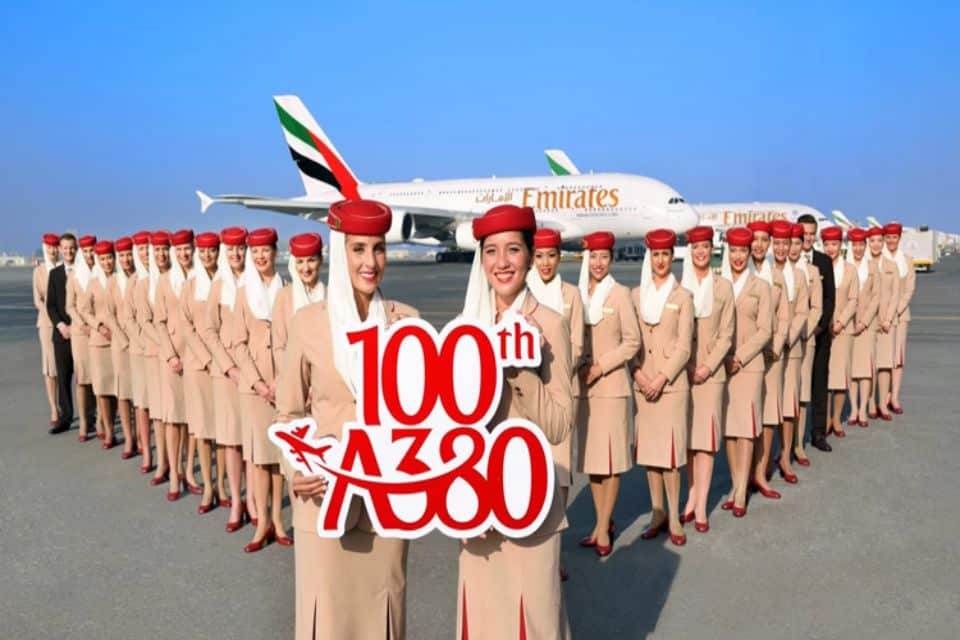
It means
- Information
- Communication
- Entertainment
Choose from up to 3000 channel of movies TV shows, music, and games on demand and in multiple language.
Did you know?
Emirates is first airline to introduce inflight entertainment system in 1992
-The airline was the seventh-largest airline in the world in terms of international passengers carried.
- It is also the seventh largest in terms of scheduled freight ton-kilometer flown
- Sixth in scheduled international freight ton-kilometer flown.
- In 2017 emirates recorded +8% growth in traffic and +3% cargo transportation.
-Emirates has the world’s largest fleet of Boeing 777z and A380s
Emirates operates a fleet of more than 250 aircraft. Emirates is also the world’s largest Boeing 777 operates with 151 aircraft in service.
Emirates finalized an order for 150 Boeing 777x aircraft, consisting of 35 (777-8s) and 115 (777-9s)
As of February 2019, Emirates is the largest airbus A380 operator with 109 aircraft in service and its introduction.
-Top 3 successful & Profitable products by emirates
- Passenger’s flights
- Air cargo
- Aviation Service
Funder & Key people Ahmed Al Maktoum (Chairman & CEO)
Time Clark (President)
Operations – 3,600 flight per week
- 140 cities
- 81 countries
- 6 continents
250 fleet size (2018)
Employee: 64,768 (2016-2017)
Emirates Sky Cargo
- 50 destinations
- 100 destinations through Emirates passenger network
Fleet size 15
- 2- Boeing 747
- 13 Boeing 777F
Till 2017 it carried 2,714 (thousands tonne-km )
Employee: 40,000
Dnata ground Handling service
Services
- Aircraft Ground handling
- Cargo, travel
- Flight catering services
Area served
- 84 countries
- 5 continents
Employee: 38,000

Aviation
BARK Air Unveils the World’s First Luxury Airline Exclusively for Dogs

Introducing BARK Air in collaboration with a jet charter firm, BARK, Inc. is a top worldwide omnichannel dog brand whose goal is to bring happiness to all dogs.
With BARK Air, dogs and their human friends can travel together in comfort and convenience. It’s the first air travel experience created with dogs in mind first. The private plane cost
first flights departing from New York on Thursday, May 23, are being offered for booking as of right now. Premium flights for dogs (and their humans) are also available.
Taking long trips with a dog can be difficult for many dog parents, especially for larger dogs who can’t fit in a carrier that fits under the front seat. Dogs suffer through the trauma of flying in cargo, are denied travel, or are confined to a duffel bag far too frequently. BARK Air private jet flights offers a more enjoyable and compassionate choice for dogs travelling with their two-legged human companions, in response to the growing need for an accessible solution to these problems.
BARK Air is a new benchmark for dogs that love to travel but have to make up with less-than-ideal travel circumstances. BARK Air embodies BARK’s dog-first ethos and award-winning customer experience. From booking to arrival, in-flight amenities, and disembarkation, dogs will genuinely be the VIPs and treated to a positively opulent, carefully planned experience by BARK Air, which has taken the white glove treatment typically associated with a human’s first-class experience and aimed all that pampering towards pups.
Routes will first serve the New York City metro area via Westchester County Airport, with flights to London, England via Stansted Airport (STN), and the Los Angeles area via Van Nuys (VNY). Through the cooperation, all aircraft, crew, maintenance, and insurance-related issues are handled by an Argus Platinum-rated charter business, while BARK is concentrated on designing and delivering an exceptional flying experience for dogs and their humans.
Aviation
Here’s Why Popular Airlines Are removing First Class : The Reasons Unveiled
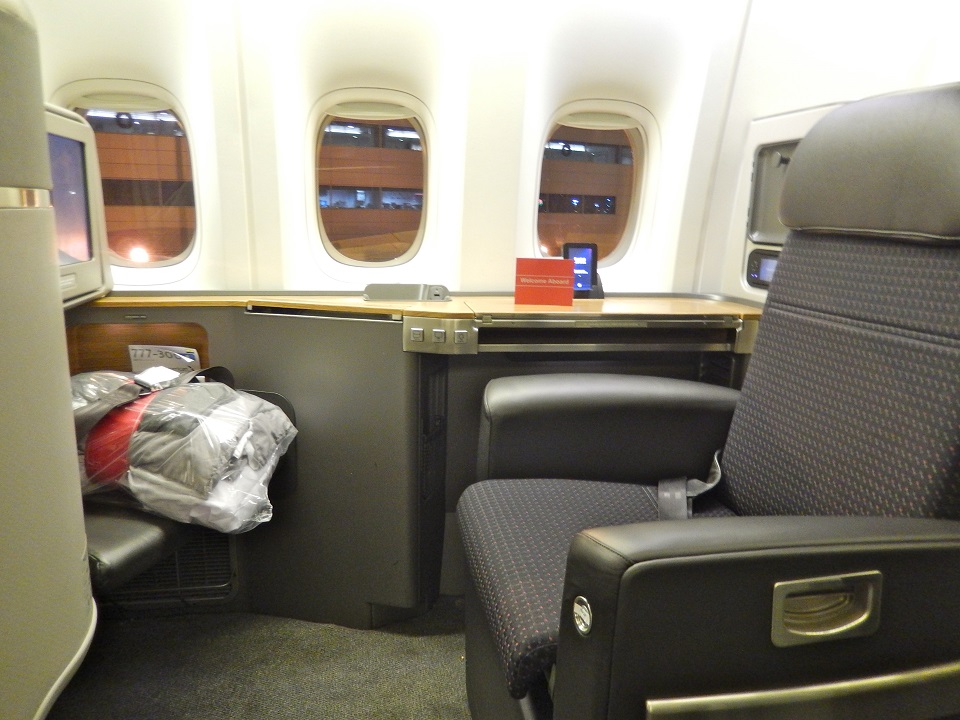
An airline has grown weary of its first-class seats and has made the bold decision to remove them from its upcoming aircraft orders and fleet interior upgrades.
Why has the airline chosen to take such a drastic step, and what has led to its lack of interest in maintaining a first-class experience? Join us in this video as we delve into the reasons behind the airline’s decision and explore its implications.
First-class seats hold a distinct identity in the travel segment, often attracting affluent individuals or celebrities seeking privacy and luxury. These passengers enjoy exclusive suites with extensive food menus and various travel amenities. Airlines have crafted their brand image around these offerings, leveraging such facilities and promotions to enhance their appeal. For instance, some airlines like Emirates provide onboard showers in their first-class cabins, while others like Singapore Airlines offer private suites resembling spacious bedrooms for their passengers.
Some popular airlines are phasing out their first-class seats from their cabins due to various reasons that have prompted them to reconsider their services.
Changing Traveler Preferences
Some leading airlines are ditching their first-class seats, reflecting a shift in traveler behavior. Passengers increasingly question the value of paying a premium for first class when business class offers comparable benefits. Additionally, affluent travelers often have access to private jets, reducing the exclusivity of first-class travel.
Egalitarian Approach to Seating
First class, once reserved for the super-rich, is losing its allure as airlines focus on providing consistent service across all cabins. The rise of business class and premium economy options has made first-class tickets less appealing to many travelers. Comfort and amenities now take precedence over traditional first-class luxuries.
Operational Efficiency
Maintaining multiple cabin classes adds complexity to airline operations. Eliminating first class can streamline processes such as boarding, catering, and service, improving overall efficiency. Furthermore, lighter aircraft resulting from reduced first-class cabins can lead to lower fuel consumption and emissions per passenger, addressing environmental concerns.
Economic Considerations
Maintaining first-class cabins entails significant expenses for airlines, including space requirements, luxurious amenities, and personalized service. High first-class fares may drive passengers to opt for private jets instead, causing potential losses for airlines.
Revenue Optimization
With more demand for economy and premium seats, airlines may find reallocating space from first class to other high-demand cabins more profitable. Increasing the number of passengers, rather than focusing on first class, can often yield higher revenue.
By considering these factors, airlines are reevaluating the role of the first class in their cabins, signaling a fundamental shift in the aviation industry’s landscape.
Environmental Impact and First-Class Seating
Concerns over environmental impact extend to the aviation industry, notably regarding the disproportionate space consumed by first-class seats, equivalent to 4-6 economy seats. This exacerbates the carbon footprint of airlines, prompting considerations for more eco-conscious practices.
Operational Challenges and Cost
The design and maintenance of first-class amenities pose formidable challenges for airlines. These include the deployment of exclusive cabin crew services and managing the added complexities, driving up operational costs significantly.
Financial Implications and Passenger Preferences
Maintaining first-class cabins proves to be financially burdensome due to their larger space requirements and luxurious amenities. Additionally, the flexibility for passengers to cancel their emirates first class seats at any time presents a risk to airlines, impacting route planning and profitability.
Alternative Travel Options and Passenger Behavior
High charges for first class seats may lead passengers, especially those traveling in groups, to opt for private jet bookings for a more personalized travel experience. This shift in passenger behavior highlights the need for airlines to adapt to changing preferences and maintain competitiveness in the market.
Maximizing Profitability Through Increased Passenger Count
Rather than persisting with a large number of underoccupied first-class seats, airlines can pivot towards a strategy focused on maximizing passenger count. By accommodating more passengers, particularly in Economy and Premium classes, airlines stand to generate higher revenue and improve profitability. This shift aligns with changing consumer preferences and market dynamics, emphasizing practicality and affordability over luxury.
In the near future, several major airlines, including American Airlines, United Airlines, Delta Air Lines, Lufthansa, British Airways, and Qantas, are planning to remove first-class seats from their aircraft. Although Emirates has not completely eliminated its first-class cabins, it is reducing the number of first-class seats on certain planes to prioritize the expansion of its business and economy class offerings.
Aviation
UK Airports Struggle to Implement Liquid Limit Changes
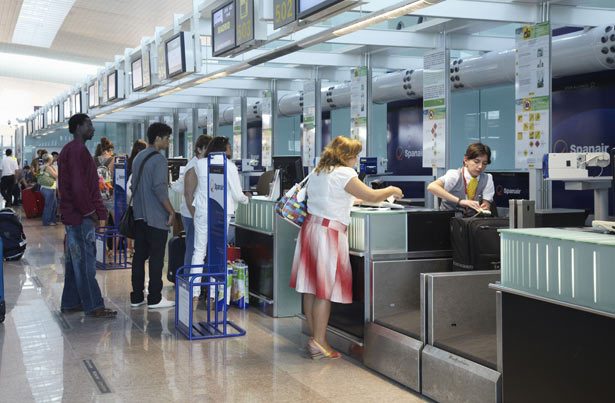
As summer approaches, travelers passing through major UK airports will continue to encounter restrictions on carrying liquids in their hand luggage, as the deadline for implementing new scanners has been extended.
Despite efforts to upgrade security technology, London Gatwick, Heathrow, and Manchester airports are unlikely to have the necessary equipment in place by the previously set date of June 1st. This delay could persist for up to a year, potentially stretching until June 2025, as airports grapple with the installation process.
The government has granted airports individual extensions, acknowledging the challenges they face in transitioning to the new scanning technology. Consequently, passengers may still be required to remove liquids and laptops from their bags during security checks. Failure to meet deadlines will result in financial penalties imposed by the Civil Aviation Authority, as announced by the UK Department of Transport.
Chris Woodroofe, managing director at Manchester Airport said to BBC, emphasized the ongoing transition, urging passengers to adhere to the existing liquid restrictions and prepare for the possibility of continued inconvenience. While some terminals may feature the new scanning lanes, the majority are still in the process of implementation.
In addition to advising travelers to comply with current regulations, passengers are urged to familiarize themselves with the rules at their destination or transfer airports, as the outdated restrictions may still apply elsewhere.
Phil Forster, managing director of Teesside Airport, expressed understanding for the challenges faced by larger airports in adapting to the new technology. The next-generation scanners, equipped with computed tomography (CT) technology, offer clearer 3D images, allowing items to remain inside bags and increasing the permissible liquid limit to two liters.

